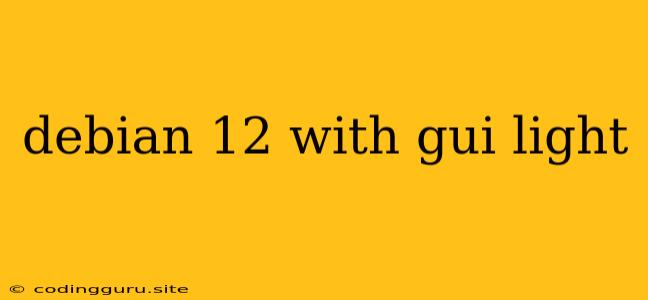Embracing the Simplicity: Setting Up a Lightweight Debian 12 Desktop
Debian 12, also known as "Bookworm," is a robust and versatile operating system. It's a favorite among enthusiasts who value stability, security, and a vast selection of software. But, if you're looking for a smooth and efficient desktop experience, sometimes a minimal, light-weight approach is the way to go.
This guide aims to help you navigate the process of installing Debian 12 and setting up a beautiful, fast, and responsive desktop environment. We'll focus on creating a system that feels nimble, perfect for older hardware or those seeking a distraction-free workspace.
Choosing the Right Tools for the Job
When it comes to a lightweight desktop experience, the choice of window manager and desktop environment plays a crucial role. Debian 12 offers several options, but for a truly light-weight setup, consider the following:
-
Xfce: Xfce stands out as a classic, mature desktop environment known for its resource-friendliness. It offers a familiar and intuitive interface without sacrificing functionality.
-
LXDE: LXDE (Lightweight X11 Desktop Environment) prioritizes minimal resource usage, making it a perfect choice for older machines. Its focus on speed and efficiency will feel like a breath of fresh air.
-
LXQt: LXQt builds upon the legacy of LXDE, introducing modern features and a fresh look. It's a great middle ground between the classic feel of LXDE and the more feature-rich Xfce.
-
Openbox: Openbox is a highly customizable window manager, giving you complete control over your desktop. While requiring a bit more manual configuration, it's an excellent option for those seeking a truly minimal and efficient experience.
The Debian 12 Installation Process
-
Download the Image: Head over to the official Debian website and download the Debian 12 (Bookworm) ISO image. Choose the "netinst" option for a minimal installation. This option downloads necessary packages during installation, keeping the image size small.
-
Create a Bootable USB Drive: Use a tool like Etcher or Rufus to create a bootable USB drive with the Debian 12 ISO image.
-
Boot from the USB Drive: Once the USB drive is ready, restart your computer and boot from it. Select the "Install" option from the boot menu.
-
Language and Keyboard Selection: Select your preferred language and keyboard layout.
-
Network Configuration: Configure your network settings to connect to the internet during installation. This will allow you to download necessary packages.
-
Disk Partitioning: This step is crucial. If you're going for a light-weight system, consider using a single partition for your entire system. This eliminates unnecessary fragmentation and optimizes disk space.
-
Choose a User: Set up your user account and password.
-
Select a Desktop Environment (Optional): While the installer offers basic packages, you can choose a specific desktop environment during installation. For a light-weight experience, select Xfce, LXDE, LXQt, or choose "none" for a minimalist approach.
-
Installation Begins: Sit back and let the Debian 12 installation process complete.
-
First Boot: Once the installation finishes, restart your computer and boot into your newly installed Debian 12 system.
Fine-Tuning your Debian 12 Desktop
After the initial installation, you're ready to customize your desktop environment for maximum efficiency. Here are some key steps:
-
Update System: Make sure your system is up-to-date by running
sudo apt update && sudo apt upgradein a terminal. This will ensure you have the latest versions of software and security updates. -
Install Essential Packages: Use
sudo apt installto install necessary applications, including a web browser, text editor, and any other software you need. Choose light-weight alternatives wherever possible. For example, instead of Firefox, consider a browser like Midori, which consumes less memory. -
Tweak Your Desktop: Each desktop environment has its own settings. Explore options for customizing your desktop appearance, including themes, icons, and window management.
-
Remove Unnecessary Packages: Once you've installed the necessary applications, use
sudo apt autoremoveto clean up any unused dependencies. This will free up valuable disk space. -
Adjust System Settings: Explore the system settings of your desktop environment. Adjust power settings, screen brightness, and other options to optimize for battery life and performance.
-
Explore Lightweight Alternatives: Search for lighter alternatives to the default applications. Many software packages are available in Debian's repositories. You can find lightweight alternatives for image editors, music players, and other frequently used programs.
Additional Tips for a Light-Weight Experience
- Use a Minimalist Theme: Opt for a minimalist desktop theme to reduce visual clutter and improve focus.
- Disable Unnecessary Services: Check for system services that you don't use and disable them to reduce system resource consumption.
- Minimize Startup Applications: Use the system settings to control which programs launch automatically at startup.
- Regularly Clean up Disk Space: Make sure you regularly clean up your system by deleting unnecessary files and emptying the trash.
Conclusion
Setting up a lightweight Debian 12 desktop involves careful planning and selection of the right tools. By choosing the right desktop environment, installing essential applications, and customizing your desktop, you can create a system that's both fast and efficient. Remember, the journey towards a lightweight Debian 12 experience is about finding the perfect balance between functionality and performance.
